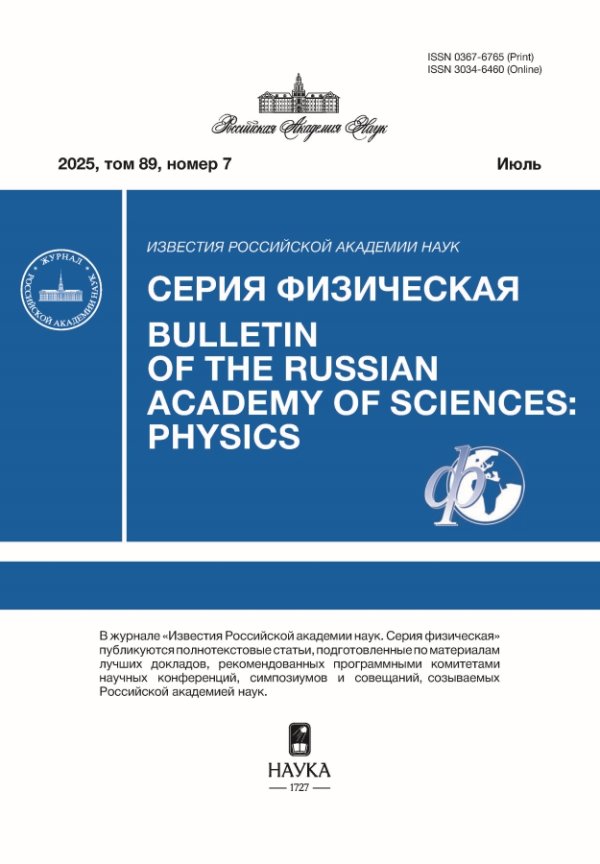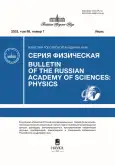Bulletin of the Russian Academy of Sciences: Physics
“Известия Российской академии наук. Серия физическая” (Izvestiya Rossiiskoi Akademii Nauk. Seriya Fizicheskaya, ISSN 0367-6765; English translation: “Bulletin of the Russian Academy of Sciences: Physics”, ISSN 1062-8738) is a Russian peer-reviewed scientific journal established in 1936 as the Bulletin of the Academy of Sciences of USSR: Physics Series. It presents full-text articles with the most recent results in miscellaneous fields of physics and astronomy: nuclear physics, cosmic rays, condensed matter physics, plasma physics, optics and photonics, nanotechnologies, solar and astrophysics, physical applications in material sciences, life sciences, etc. The journal focuses on the most relevant multidisciplinary topics in natural sciences, both fundamental and applied.
For more than 80 years, the main purpose of the journal is to provide authors with the opportunity to publish and discuss the results of relevant fundamental and applied scientific research, presented at conferences, symposiums and scientific schools, organized by the Russian Academy of Sciences, which are recognized by the world scientific community and interdisciplinary experts. The journal accepts for publishing full-text articles, which are prepared on the base of best talks, recommended by program committees of the scientific events, which are of interest to a wide range of readers. Articles containing new and previously unpublished results are peer-reviewed by at least two independent reviewers and are published in special thematic issues of the journal. The journal is open for publishing of the most authoritative and advanced research results in the field of fundamental and applied physics, obtained in Russia and neighboring countries, as well as from authors from all over the world.
The journal is published by the Russian Academy of Sciences under the conduction of the Physical Sciences Division of RAS. The originator is the Editorial Board of the journal “Bulletin of the Russian Academy of Sciences: Physics”.
Until 2018, the journal was published by “Nauka” Publishing House.
Preparation of the original layout and publication of the journal is currently carried out under the state contract by LLC “Thematic Editorial”.
Certificate of registration of mass media ПИ No. ФС 77 – 82377 dated December 10, 2021, issued by the Ministry of press and information of the Russian Federation.
The journal is included in the List of journals recognized by the Higher Attestation Commission of the Ministry of Science and Higher Education of the Russian Federation and included into the Russian scientific citation system RSCI. The translated version of the journal – Bulletin of the Russian Academy of Sciences: Physics – is indexed in Scopus and is included in the Russian Science Citation Index database on the Web of Science platform.
English version of the journal – Bulletin of the Russian Academy of Sciences. Physics is published by Allerton Press Inc. (Pleiades Publishing) and distributed by Springer Nature Switzerland AG.
Edição corrente
Volume 89, Nº 7 (2025)
Magnetohydrodynamics
The method of incoherent decomposition in the theory of kinematic dynamo
Resumo
 1008-1013
1008-1013


Influence of magnetic field on the spectra of optical effects in magnetic fluids with different aggregative stability
Resumo
 1014-1020
1014-1020


Non-conservative cascades in MHD turbulence
Resumo
 1021-1027
1021-1027


Experimental verification of Couette-Poiseuille flow of a magnetic fluid filling coaxial gap between the inner magnetic and external nonmagnetic walls
Resumo
 1028-1036
1028-1036


Correlation analysis of the interaction of surface magneto-hydrodynamic waves
Resumo
 1037-1042
1037-1042


Formation of near-surface toroidal magnetic fields of the Sun. Extended solar cycle
Resumo
 1043-1049
1043-1049


Features of the temperature dependence of the deformation processes of microdroplets of magneto-sensitive emulsion in constant and alternating magnetic fields
Resumo
 1050-1058
1050-1058


Dynamics of a chain of interacting magnetic particles in a one-dimensional periodic energy landscape
Resumo
 1059-1065
1059-1065


The influence of the magnetic field on photo-induced thermocapillary deformation of the surface of a magnetic fluid layer
Resumo
 1066-1071
1066-1071


Comparative analysis of experimental methods for measuring the magnetoviscous effect
Resumo
 1072-1077
1072-1077


Magnetic field structures generated by accretion disc dynamo
Resumo
 1078-1083
1078-1083


Investigation of the controlled motion of a magnetically active object in a viscous liquid
Resumo
 1084-1090
1084-1090


The role of magnetorotation instability in the occurrence of magnetic field on the periphery of the galactic disk
Resumo
 1091-1096
1091-1096


Vortex flow of electrolytes caused by the interaction of electric current and magnetic field in a cylindrical cell
Resumo
 1097-1102
1097-1102


Numerical study of the effect of the electrical conductivity of the pipe wall on the flow of a salt melt simulator during an upward flow in a transverse magnetic field
Resumo
 1103-1108
1103-1108


Unsteady fluctuations of a liquid metal flow in a closed volume inside an alternating magnetic field
Resumo
 1109–1114
1109–1114


Laboratory and numerical modeling of the structure of shock waves of young stars' jets
Resumo
 1115-1122
1115-1122


Characteristics of a liquid metal flow generated by a travelling magnetic field in a hollow cylindrical channel and a channel with a coaxial insert
Resumo
 1123-1129
1123-1129


Induction sensor for control of boundary position and medium electrical conductivity
Resumo
 1130-1137
1130-1137


On the simplest solutions for the total magnetic energy in the convective zone of the Sun and the Earth
Resumo
 1138-1142
1138-1142


Comparison of the single-step and multistep approaches to prediction of the solar activity index
Resumo
 1143-1148
1143-1148


Synchronization effect in a nonlinear solar dynamo model
Resumo
 1149-1153
1149-1153


Interaction of multi-directional rotating MHD flow of liquid metal in a cylindrical channel
Resumo
 1154-1160
1154-1160


Surface deformation effect in In-Ga-Sn liquid metal system with hemispherical electrodes
Resumo
 1161-1166
1161-1166


Heat transfer of liquid metal in the heat exchange system "pipe in the channel" in relation to the blanket module of a thermonuclear reactor
Resumo
 1167-1174
1167-1174












